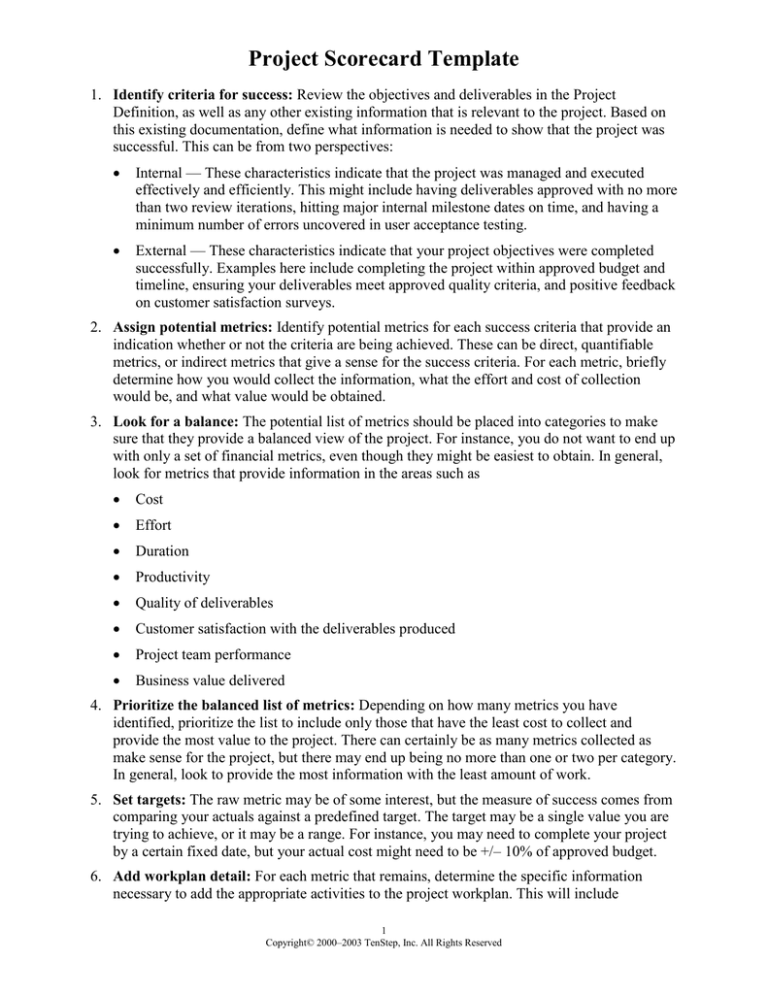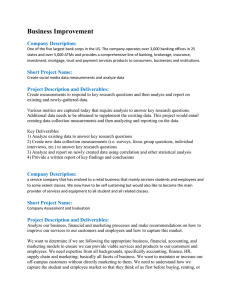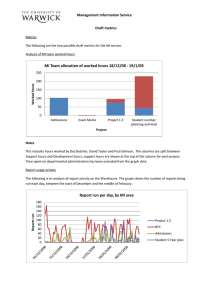
Project Scorecard Template
1. Identify criteria for success: Review the objectives and deliverables in the Project
Definition, as well as any other existing information that is relevant to the project. Based on
this existing documentation, define what information is needed to show that the project was
successful. This can be from two perspectives:
Internal — These characteristics indicate that the project was managed and executed
effectively and efficiently. This might include having deliverables approved with no more
than two review iterations, hitting major internal milestone dates on time, and having a
minimum number of errors uncovered in user acceptance testing.
External — These characteristics indicate that your project objectives were completed
successfully. Examples here include completing the project within approved budget and
timeline, ensuring your deliverables meet approved quality criteria, and positive feedback
on customer satisfaction surveys.
2. Assign potential metrics: Identify potential metrics for each success criteria that provide an
indication whether or not the criteria are being achieved. These can be direct, quantifiable
metrics, or indirect metrics that give a sense for the success criteria. For each metric, briefly
determine how you would collect the information, what the effort and cost of collection
would be, and what value would be obtained.
3. Look for a balance: The potential list of metrics should be placed into categories to make
sure that they provide a balanced view of the project. For instance, you do not want to end up
with only a set of financial metrics, even though they might be easiest to obtain. In general,
look for metrics that provide information in the areas such as
Cost
Effort
Duration
Productivity
Quality of deliverables
Customer satisfaction with the deliverables produced
Project team performance
Business value delivered
4. Prioritize the balanced list of metrics: Depending on how many metrics you have
identified, prioritize the list to include only those that have the least cost to collect and
provide the most value to the project. There can certainly be as many metrics collected as
make sense for the project, but there may end up being no more than one or two per category.
In general, look to provide the most information with the least amount of work.
5. Set targets: The raw metric may be of some interest, but the measure of success comes from
comparing your actuals against a predefined target. The target may be a single value you are
trying to achieve, or it may be a range. For instance, you may need to complete your project
by a certain fixed date, but your actual cost might need to be +/– 10% of approved budget.
6. Add workplan detail: For each metric that remains, determine the specific information
necessary to add the appropriate activities to the project workplan. This will include
1
Copyright© 2000–2003 TenStep, Inc. All Rights Reserved
What specific data is needed for the metrics?
Who is responsible for collecting the metric?
When will the metric be collected and reported?
How will the metrics be reported (status reports, quarterly meetings, metrics reports)?
2
Copyright© 2000–2003 TenStep, Inc. All Rights Reserved
Potential Scorecard Metrics
1.
2.
3.
4.
Identify criteria for success.
Assign potential metrics.
Look for a balance.
Prioritize the balanced list of metrics.
Int
/ Ext
Int
Success Criteria (1)
Potential Metric (2)
Ext
The project team must communicate proactively.
All project status reports must be completed on
time and sent to the project manager.
The deliverables must be correct the first time.
We must establish completeness and correctness
criteria for all major deliverables.
We must deliver this project by year end.
Ext
The application must have quick response time.
Int
Ext
The application must have quick response time.
The percentage of status reports that are
late/number of status reports due per month
Each major deliverable must have customerapproved completeness and correctness criteria
(100%)
The date that the project is formally approved
by the sponsor
The average system response time at peak
utilization, between 1:00 and 3:00 p.m.
Survey the end users to determine their
satisfaction level with overall response time.
3
Copyright© 2000–2003 TenStep, Inc. All Rights Reserved
Balance
Category (3)
Project Team
Performance
Priority
(H/M/L) (4)
M
Project Team
Performance
H
Duration
H
Quality
(Performance)
Quality
(Performance)
L
(Hard to collect)
H
(Easy to collect)
Detailed Project Scorecard
For those balanced metrics that are of the highest priority (easiest to collect/least cost)
5. Set targets.
6. Add workplan detail.
Metric
List the metrics that you are
actually going to collect.
Status reports late/status reports
due
Target (5)
What is the unit of
measure? What is our
performance target?
No more than 5% late
Deliverables with C & C
criteria/
# Major deliverables
Formal project approval date
100%
System response time
Satisfaction survey
average 3.5 out of a 5.0
scale
December 31
Data Needed (6)
What data do we need?
# Status reports due
# Status reports late
# Deliverables with C & C
criteria
# major deliverables
Formal acceptance
document signed by the
sponsor
Survey to end users
Metric Gathering (6)
Who is responsible for
collecting the metric and
how often?
Project manager
Monthly
Metric Gathering (6)
How are we going to collect
the data?
Metric Sharing (6)
How will we share the
information and how often?
Manually
Quarterly status reports and
final status report at the end
of the project
Quarterly status reports and
final status report at the end
of the project
Final status report at end of
project
Lead analysts
Monthly
Manually
Project manager
Manually
Implementation leader
Manually, using e-mail
survey
4
Copyright© 2000–2003 TenStep, Inc. All Rights Reserved
Final status report at end of
project
Sample Categories and Metrics
The following list provides ideas on the types of metrics that could be reported. This list is not
exhaustive by any means, but may help provide additional ideas for your project.
Balance
Category
Sample Metrics
Cost
Actual cost vs. budget (variance) for project, for phase, for activity, etc.
Total support costs for x months after solution is completed
Total labor costs vs. non labor (vs. budget)
Total cost of employees vs. contract vs. consultant (vs. budget)
Cost associated with building components for reuse
Total cost per transaction
Ideas for cost reductions implemented, and cost savings realized
Effort
Actual effort vs. budget (variance)
Amount of project manager time vs. overall effort hours
Duration
Actual duration vs. budget (variance)
Productivity
Effort hours per unit of work/function point
Work units/function points produced per effort hour
Effort hours reduced from standard project processes
Effort hours saved through reuse of previous deliverables, models, components,
etc.
Number of process improvement ideas implemented
Number of hours/dollars saved from process improvements
Difficult to measure
accurately unless function
points are counted.
Quality of
Deliverables
Percentage of deliverables going through quality reviews
Percentage of deliverable reviews resulting in acceptance the first time
Number of defects discovered after initial acceptance
Percentage of deliverables that comply 100% with organization standards
Percentage of deliverables that comply with organization architectural standards
Number of customer change requests to revise scope
Number of hours of rework to previously completed deliverables
Number of best practices identified and applied on the project
Number of risks that were successfully mitigated
Customer
Satisfaction
with
Deliverables
Overall customer satisfaction (survey) with deliverables in terms of:
Reliability
Minimal defects
Usability
Response time
Ease of use
Availability
Flexibility
Intuitiveness
5
Copyright© 2000–2003 TenStep, Inc. All Rights Reserved
Security
Meeting customer needs
Easy-to-understand messages
User documentation
Application response time (calculated by the system)
Number of approved business requirements satisfied by the project
Customer
Satisfaction
with Project
Team
Overall customer satisfaction (survey) with the project team in terms of:
Responsiveness
Competence
Accessible
Courteous
Good communication
Credible
Knowledge of the customer
Reliable/follows through on commitments
Professionalism
Training provided
Overall customer satisfaction
Turnaround time required to respond to customer queries and problems
Average time required to resolve issues
Number of scope change requests satisfied within original project budget and
duration
Business Value
Based on the cost/benefit analysis, or the value proposition, that was created
when the project was approved and funded
6
Copyright© 2000–2003 TenStep, Inc. All Rights Reserved





